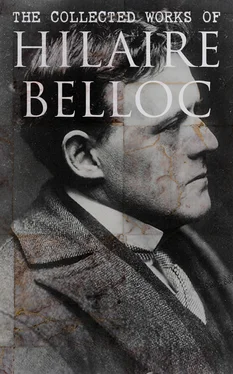If by a “feint” is meant a subsidiary part of the general plan, the expression might be allowed to pass, but it is not a legitimate use of that expression, and if, as occurred at Malplaquet with the Dutch troops, a subsidiary body in the general plan is badly commanded, the temptation to call the original movement a “feint,” which developed from breach of orders into a true attack, though strong for the disappointed commanders, must not be admitted by the accurate historian. In general, we may be certain that the Dutch troops and their neighbours on the allied left were intended to do all they could against the wood of Lanière, did all they could, but suffered in the process a great deal more than Marlborough had allowed for.
* * * * *
These dispositions once grasped, we may proceed to the nature and development of the general attack which followed that opening cannonade of half-past seven, which has already been described.
The first movement of the allies was an advance of the left under the Prince of Orange and of the right under Lottum. The first was halted out of range; the second, after getting up as far as the eastern flank of the forest of Sars, wheeled round so as to face the hedge lining that forest, and formed into three lines. It was nine o’clock before the signal for the attack was given by a general discharge of the great battery in the centre opposite the French entrenchments in the gap. Coincidently with that signal Schulemberg attacked the forest of Sars from his side, the northern face, and he and Lottum pressed each upon that side of the salient angle which faced him. Schulemberg’s large force got into the fringe of the wood, but no further. The resistance was furious; the thickness of the trees aided it. Eugene was present upon this side; meanwhile Marlborough himself was leading the troops of Lottum. He advanced with them against a hot fire, passed the swampy rivulet which here flanks the wood, and reached the entrenchments which had been drawn up just within the outer boundary of it.
This attack failed. Villars was present in person with the French troops and directed the repulse. Almost at the same time the advance of Schulemberg upon the other side of the wood, which Eugene was superintending, suffered a check. Its reserves were called up. The intervals of the first line were filled up from the second. One French brigade lining the wood was beaten back, but the Picardy Regiment and the Marines stood out against a mixed force of Danes, Saxons, and Hessians opposing them. Schulemberg, therefore, in this second attack had failed again, but Marlborough, leading Lottum’s men upon the other side of the wood to a second charge in his turn, had somewhat greater success. He had by this time been joined by a British brigade under the Duke of Argyle from the second line, and he did so far succeed with this extension of his men as to get round the edge of the French entrenchments in the wood.
The French began to be pressed from this eastern side of their salient angle, right in among the trees. Schulemberg’s command felt the advantage of the pressure being exercised on the other side. The French weakened before it, and in the neighbourhood of eleven o’clock a great part of the forest of Sars was already filled with the allies, who were beating back the French in individual combats from tree to tree. Close on noon the battle upon this side stood much as the sketch map upon the opposite page shows, and was as good as won, for it seemed to need only a continuation of this victorious effort to clear the whole wood at last and to turn the French line.
This is undoubtedly the form which the battle would have taken—a complete victory for the allied forces by their right turning the French left—and the destruction of the French army would have followed, had not the allied left been getting into grave difficulty at the other end of the field of battle.

Sketch Map showing the peril the French centre ran towards
noon of being turned on its left.
The plan of the allied generals, it will be remembered, was that the left of their army under the Prince of Orange should attack the wood of Lanière about half an hour after the right had begun to effect an entrance into the opposing forest of Sars. When that half hour had elapsed, that is, about half-past nine, the Prince of Orange, without receiving special orders, it is true, but acting rightly enough upon his general orders, advanced against the French right. Tullibardine with his Scottish brigade took the worst of the fighting on the extreme left against the extreme of the French right, and was the first to get engaged among the trees. The great mass of the force advanced up the opening between the coppice called the wood of Tiry and the main wood, with the object of carrying the entrenchments which ran from the corner of the wood in front of Malplaquet and covered this edge of the open gap. The nine foremost battalions were led by the Prince of Orange in person; his courage and their tenacity, though fatal to the issue of the fight, form perhaps the finest part of our story. As they came near the French earthworks, a French battery right upon their flank at the edge of the wood opened upon them, enfilading whole ranks and doing, in the shortest time, terrible execution. The young leader managed to reach the earthworks. The breastwork was forced, but Boufflers brought up men from his left, that is, from the centre of the gap, drove the Dutch back, and checked, at the height of its success, this determined assault. Had not the wood of Tiry been there to separate the main part of the Prince of Orange’s command from its right, reinforcements might have reached him and have saved the disaster. As it was, the wood of Tiry had cut the advance into two streams, and neither could help the other. The Dutch troops and the Highlanders rallied; the Prince of Orange charged again with a personal bravery that made him conspicuous before the whole field, and should make him famous in history, but the task was more than men could accomplish. The best brigade at the disposal of the French, that of Navarre, was brought up to meet this second onslaught, broke it, and the French leapt from the earthworks to pursue the flight of their assailants. Many of Orange’s colours were taken in that rout, and the guns of his advanced battery fell into French hands. Beyond the wood of Tiry the extreme right of the Dutch charge had suffered no better fate. It had carried the central entrenchment of the French, only to be beaten back as the main body between the wood of Tiry and the wood of Lanière opened.
At this moment, then, after eleven o’clock, which was coincident with the success of Lottum and Schulemberg in the forest of Sars, upon the right, the allied left had been hopelessly beaten back from the entrenchments in the gap, and from the edge of the wood of Lanière.
Marlborough was hurriedly summoned away from his personal command of Lottum’s victorious troops, and begged to do what he could for the broken regiments of Orange. He galloped back over the battlefield, a mile or so of open fields, and was appalled to see the havoc. Of the great force that had advanced an hour and a half before against Boufflers and the French right, fully a third was struck, and 2000 or more lay dead upon the stubble and the coarse heath of that upland. The scattered corpses strewn over half a mile of flight from the French entrenchments, almost back to their original position, largely showed the severity of the blow. It was impossible to attempt another attack upon the French right with any hope of success.
Marlborough, trusting that the forest of Sars would soon be finally cleared, determined upon a change of plan. He ordered the advance upon the centre of the position of Lord Orkney’s fifteen battalions, reinforced that advance by drafts of men from the shattered Dutch left, and prepared with some deliberation to charge the line of earthworks which ran across the open and the nine redans which we have seen were held by the French allies and mercenaries from Bavaria and Cologne, and await his moment. That moment came at about one o’clock; at this point in the action the opposing forces stood somewhat as they are sketched on the map over page.
Читать дальше













